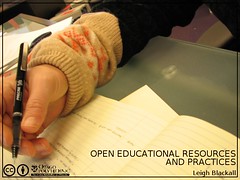
SML Flickr goes Creative Commons /
2007-12-30 / SML Screenshots
Originally uploaded by See-ming Lee 李思明 SML.
This week we are looking at the history of copyright, how it is being expanded in modern times, and how the use of creative commons and similar licences can help in the creation of an alternative to copyright, a “commons” of material available for use. This commons can include free and open educational resources.
An argument that is often heard in favour of copyright is that without copyright artists, authors and similar would not be rewarded for creating their works. Like all good arguments there is an element of truth in this but it was interesting to read in the history of copyright that the first common-law forms of protection actually protected publishers and not authors. In some ways the wheel seems to have turned full circle, again protecting the corporate owners rather than the authors of works. As Lawrence Lessig points out, modern copyright in the
It is not in itself problematic to grant certain rights to the creator and owner of a “work”. That they are able to benefit from their work is only fair, but if that protection becomes too comprehensive then it hinders the creation of new works. Our previous reading (Standing on the Shoulders of Giants) and Lawrence Lessig's presentation points out that all new “works” are built upon what went before them. If creators are denied the right to use what went before then this hinders them in their act of creation. The difference between “copying” and “creative derivation” is not always obvious. Lessig’s example of the Disney Corporation’s careful guarding of their creations from any form of copying or derivative use shows how copyright can be used to frustrate development. That many of Disney’s creations were built upon material in the public domain, and that Disney has effectively removed aspects of this material from the public domain makes matters even more frustrating!
The creation of open resources, with creative commons licences, bypasses this copyright problem. It gives the author/owner certain rights, ensures that the material cannot be destructively copyrighted and at the same time allows for the creative cycle to continue, building upon the work in question. Bissell and Boyle in "Towards a Global Learning Commons: ccLearn" point out in the importance of licences being compatible if the work is to be reused. I have already come across this problem. I moved some of my photographs from Flickr to Wikiversity and found that not all levels of CC licences used in Flickr were accepted in Wikiversity.
Bissell and Boyle also divided OER into levels – their lowest level, minus one(!) is interestingly numbered. The use of “minus” shows that this level of openness is not really very useful, even if it is better than nothing! The problems of incompatibility that they raise have also appeared in the work of CFL in
Rose has already written about Swedish copyright laws in her posting so I won't repeat that. However, I will mention a couple of other points. Swedish law allows for the limited non-commercial copying of CD’s and DVD’s under a “personal use” definition. If I wish to make a copy of a CD and give it to a friend I can do that legally. This right is rather restricted and a special duty on copying mediums (blank CD’s and DVD’s) pays for this right.




